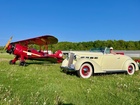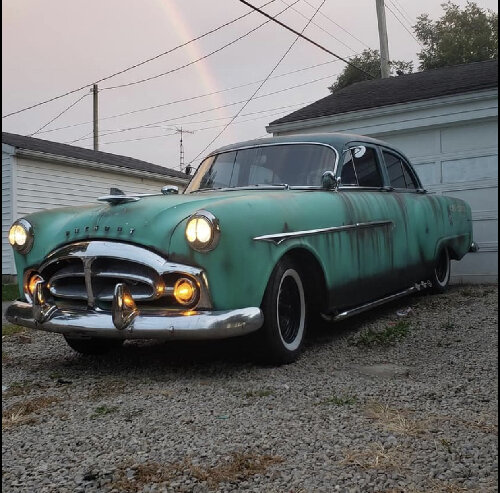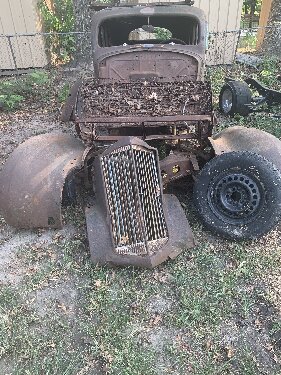|
Re: V-8 head part nbr vs cast nbr
|
||||
|---|---|---|---|---|
|
Home away from home

|
The CCs in the table seem just a bit different than I got for head volume. Did you remember to subtract the block deck volume and head gasket volume in your calculations? For the actual head combustion chamber, I calculate:
'56 352" - 75 cc '55 352" - 86 cc '55 320" - 78 cc thnx, jack vines
Posted on: 2008/9/22 13:11
|
|||
|
||||
|
Re: Carburetor Adapters
|
||||
|---|---|---|---|---|
|
Home away from home

|
Thanks, JD. Firefox was indeed the problem.
Posted on: 2008/9/22 10:11
|
|||
|
||||
|
Re: Carburetor Adapters
|
||||
|---|---|---|---|---|
|
Home away from home

|
Hi, Kev,
For whatever reason, the VintageSpeed.com site, which worked last week won't open for me this week. Anyone else having a problem? thnx, jack vines
Posted on: 2008/9/21 21:40
|
|||
|
||||
|
Re: V-8 head part nbr vs cast nbr
|
||||
|---|---|---|---|---|
|
Home away from home

|
AFAIK, all '56 heads were the same and are the smallest. That's where the 9.5 and 10.0 compression comes from.
thnx, jack vines.
Posted on: 2008/9/21 21:38
|
|||
|
||||
|
Re: Broke down.
|
||||
|---|---|---|---|---|
|
Home away from home

|
Two things here don't add up for me:
1. I've never seen a Packard V8 with .012" valve guide wear. May be common, I've just never seen it. 2. That sort of valve guide wear noise wouldn't come on suddenly. It starts soft and gets progressively louder over a long time. Wonder if it could be rather a sticking valve which is hanging open and then closing with a clang? Could even be sticking open enough to be hitting the piston. I've seen pistons with valve marks on them, but attributed that to over-revving and lifter pump up. thnx, jack vines
Posted on: 2008/9/21 18:40
|
|||
|
||||
|
Re: Broke down.
|
||||
|---|---|---|---|---|
|
Home away from home

|
It is usually the three middle mains which are the worst first, but I've seen all five into the copper. I'd say 80% of Packard V8s have had main bearing replacement and the crank turned .010", but less than 50% have had rod bearings. I have found one with .003" oversize piston pins in STD bore pistons. I have yet to tear down an engine which has been bored oversize. Every Golden Hawk engine had evidence of a dropped valve. One had a sleeved cylinder, one had the entire top of a piston gone, one has nicks in the bottom of a cylinder bore, evidence of either a broken piston or thrown rod. The OEM Packard intake valves are just too heavy for the springs. Add the problem caused by the first-generation retainers being too soft and it didn't take many races to drop a valve.
thnx jack vines
Posted on: 2008/9/20 16:29
|
|||
|
||||
|
Re: Broke down.
|
||||
|---|---|---|---|---|
|
Home away from home

|
FWIW, remember, this engine has perfect oil pressure, as described in the initial post. How then does it have an oil pump problem allowing the lifters to clatter enough to require a flat bed ride home? Lifters click and clack. They don't make the "sharp metallic rap" like a big ball pein hammer hitting iron. Spun rod bearings are not common on Packard V8s. Could be a rod, but the main bearings usually fail way before the rods.
Don't guess. Do the diagnostics. Pull the rocker covers. Pull one plug wire at a time. Let us know what you find. thnx, jack vines
Posted on: 2008/9/20 12:29
|
|||
|
||||
|
Re: V-8 head part nbr vs cast nbr
|
||||
|---|---|---|---|---|
|
Home away from home

|
Yes, if the 320" heads are 8cc smaller than the 352" heads, that would be why they can have the same 8.5 compression ratio.
Yes, putting the 352" heads on the 320" Hash engines would drop the C.R. to 7.8, because if they are 8cc larger, thus the lower ratio. It checks mathematically. What is the question? thnx, jack vines
Posted on: 2008/9/18 23:51
|
|||
|
||||
|
Re: V-8 head part nbr vs cast nbr
|
||||
|---|---|---|---|---|
|
Home away from home

|
Hi, Kev,
Is it desirable to move the crankshaft info to a different thread? Seems if we might make future searches easier if we left this one thread for head numbers, started another for crankshafts and I plan to begin another for connecting rods. thnx, jack vines
Posted on: 2008/9/18 10:20
|
|||
|
||||








